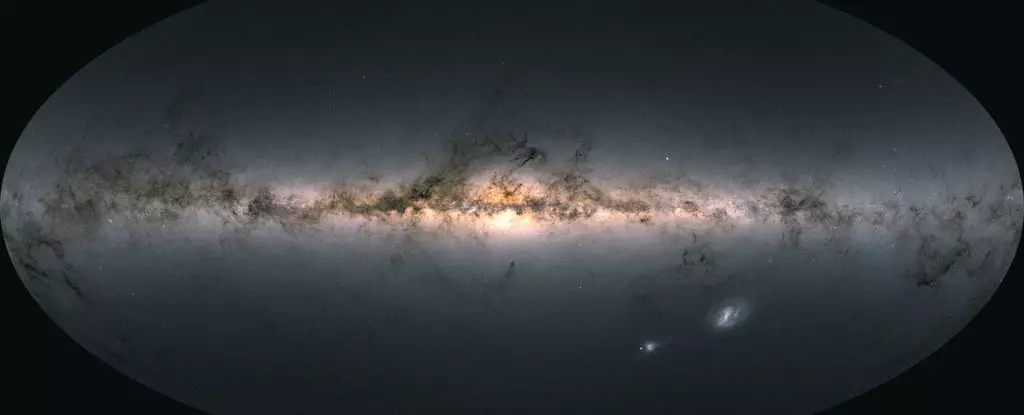The vastness of the universe has long charmed and perplexed scientists and enthusiasts alike. With every passing discovery, our comprehension of cosmic entities deepens, while simultaneously revealing intricate complexities we have yet to unravel. A recent study, led by astrophysicist Jiwon Jesse Han at the Harvard & Smithsonian Center for Astrophysics, showcases the potential presence of a substantial black hole within the Large Magellanic Cloud (LMC)—a dwarf galaxy that orbits our Milky Way. This finding may hold profound implications regarding the formation and growth of black holes across the cosmos.
Located approximately 160,000 light-years from Earth, the Large Magellanic Cloud has captivated astronomers for centuries. As a satellite galaxy of the Milky Way, this celestial neighbor is gradually spiraling towards our galaxy, with an anticipated collision projected in roughly 2 billion years. This impending merge raises questions—not only about the physical interaction between these two massive entities, but also about the hidden phenomena residing within them, such as supermassive black holes (SMBHs).
Recent research suggests that a black hole potentially weighing around 600,000 solar masses lurks deep within the LMC. What sets this black hole apart is its mass being situated in a rare range, below the typical threshold of one million solar masses often associated with SMBHs. Its confirmation could provide a valuable data point in the ongoing quest to understand the evolutionary pathways that create these enigmatic cosmic titans.
Detecting the Indetectable: The Black Hole Dilemma
Spotting black holes is an astronomical challenge due to their elusive nature. They do not emit light themselves and are only “seen” when they interact with nearby matter. This interaction often manifests as fierce radiation when matter spirals towards the black hole, revealing its presence. However, when inactive, black holes require clever strategies for detection. One such strategy involves monitoring the orbits of nearby stars, which can hint at a black hole’s gravitational influence.
Han and his team, however, took a different approach. Rather than focusing on standard orbital patterns, they studied hypervelocity stars—exceptionally fast-moving celestial bodies that can travel at speeds exceeding their peers. These stars, propelled by gravitational interactions (specifically, the Hills mechanism involving a three-body interaction between two stars and a black hole), may offer clues pointing to the existence of hidden black holes.
Harnessing Gaia: A New Frontier in Star Mapping
The breakthrough in this research can be largely attributed to the data gathered from the Gaia space telescope, which meticulously mapped stellar positions and movements within our galaxy. By analyzing the orbits and trajectories of 21 hypervelocity stars in the outer Milky Way, Han and his colleagues employed the Hills mechanism to trace their origins.
A significant aspect of their analysis revealed that seven of the hypervelocity stars had roots near Sagittarius A*, the supermassive black hole at the Milky Way’s nucleus, while the remaining nine originated from the LMC, implying ejection likely caused by this newfound black hole. This suggests that a massive, dark entity may be complicit in the peculiar behaviors of these stars, enforcing the idea that black holes are not just idle observers in the galactic theater but active participants.
With the Milky Way and the Large Magellanic Cloud on a collision course, the dynamics of their eventual merger lead to fascinating possibilities. As these two galaxies converge, the newly-massive collection of cosmic matter could result in the merging of the suspected black hole in the LMC with Sagittarius A*, potentially spawning an even more formidable black hole. This cascading process sheds light on how black holes grow over time, from smaller seed masses to monolithic entities that could rival entire galaxies.
The implications of this work are profound, not only for our understanding of the cosmic architecture but also for discerning how black holes evolve. Confirmation of the newly identified black hole in the LMC could open new gateways in astrophysical research, offering a unique opportunity to scrutinize the life cycle of black holes. The desire for continued research is palpable among astronomers; each moment spent studying these phenomena could lead to further revelations about fundamental questions regarding the nature of our universe.
The study of hypervelocity stars and the potential black hole within the Large Magellanic Cloud beckons further exploration into the depths of our universe. As we peel back the layers of cosmic mystery, we inch closer to grasping the immense forces at play in our galaxy—and perhaps even in those that lie beyond.


Leave a Reply